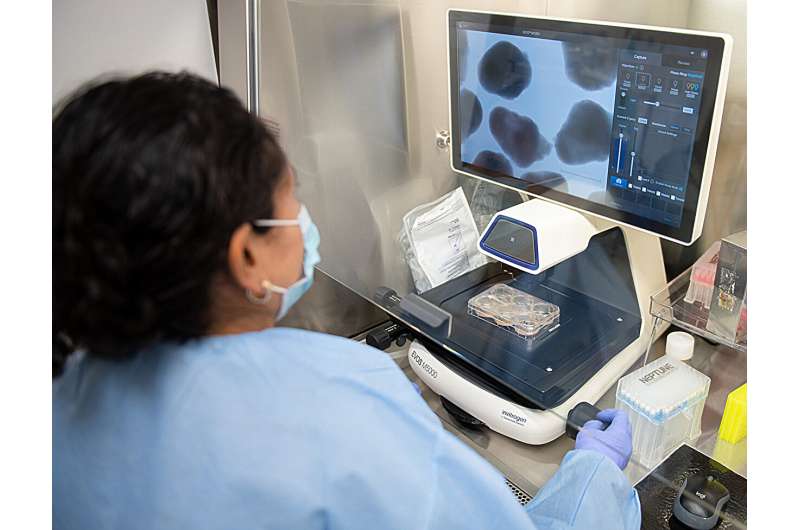Researchers worldwide can now create highly realistic brain cortical organoids—essentially miniature artificial brains with functioning neural networks—thanks to a proprietary protocol released this month by researchers at the University of California San Diego.
The new technique, published in Nature Protocols, paves the way for scientists to perform more advanced research regarding autism, schizophrenia and other neurological disorders in which the brain’s structure is usually typical, but electrical activity is altered.
That’s according to Alysson Muotri, Ph.D., corresponding author and director of the UC San Diego Sanford Stem Cell Institute (SSCI) Integrated Space Stem Cell Orbital Research Center. The SSCI is directed by Dr. Catriona Jamieson, a leading physician-scientist in cancer stem cell biology whose research explores the fundamental question of how space alters cancer progression.
The newly detailed method allows for the creation of tiny replicas of the human brain so realistic that they rival “the complexity of the fetal brain’s neural network,” according to Muotri, who is also a professor in the UC San Diego School of Medicine’s Departments of Pediatrics and Cellular and Molecular Medicine. His brain replicas have already traveled to the International Space Station (ISS), where their activity was studied under conditions of microgravity.
Two other protocols for creating brain organoids are publicly accessible, but neither allow researchers to study the brain’s electrical activity. Muotri’s method, however, allows researchers to study neural networks created from the stem cells of patients with various neurodevelopmental conditions.
“You no longer need to create different regions and assemble them together,” said Muotri, adding that his protocol allows different brain areas—like the cortex and midbrain—”to co-develop, as naturally observed in human development.”
“I believe we will see many derivations of this protocol in the future for the study of different brain circuits,” he added.

Such “mini-brains” can be used to test potentially therapeutic drugs and even gene therapies before patient use, as well as to screen for efficacy and side effects, according to Muotri.
A plan to do so is already in the works. Muotri and researchers at the Federal University of Amazonas in Manaus, Amazonas, Brazil, are teaming up to record and investigate Amazonian tribal remedies for Alzheimer’s disease—not on Earth-based mouse models, but on diseased human brain organoids in space.
The research project spans multiple continents and habitats, from the depths of the Amazon rainforest to Muotri’s lab on the coast of California—and, eventually, will reach the International Space Station.
Other research possibilities for the brain organoids include disease modeling, understanding human consciousness and additional space-based experiments. In March, Muotri—in partnership with NASA—sent to space a number of brain organoids made from the stem cells of patients with Alzheimer’s disease and ALS (amyotrophic lateral sclerosis, also known as Lou Gehrig’s disease). The payload returned in May and the results, which will eventually be published, are being reviewed.
Because microgravity mimics an accelerated version of Earth-based aging, Muotri should be able to witness the effects of several years of disease progression while studying the month-long mission’s payload, including potential changes in protein production, signaling pathways, oxidative stress and epigenetics.
“We’re hoping for novel findings—things researchers haven’t discovered before,” he said. “Nobody has sent such a model into space, until now.”
Co-authors of the study include Michael Q. Fitzgerald, Tiffany Chu, Francesca Puppo, Rebeca Blanch and Shankar Subramaniam, all of UC San Diego, and Miguel Chillón, of the Universitat Autònoma de Barcelona and the Institució Catalana de Recerca i Estudis Avançats, both in Barcelona, Spain. Blanch is also affiliated with the Universitat Autònoma de Barcelona.
More information:
Michael Q. Fitzgerald et al, Generation of ‘semi-guided’ cortical organoids with complex neural oscillations, Nature Protocols (2024). DOI: 10.1038/s41596-024-00994-0
Citation:
Research team develops first-in-kind protocol for creating ‘wired miniature brains’ (2024, June 10)
retrieved 10 June 2024
from https://medicalxpress.com/news/2024-06-team-kind-protocol-wired-miniature.html
This document is subject to copyright. Apart from any fair dealing for the purpose of private study or research, no
part may be reproduced without the written permission. The content is provided for information purposes only.

